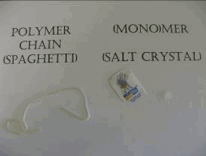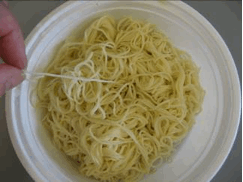Introduction to Polymers
Molecules are compounds that are made of more than one type of atom. An example of a small molecule is water--it contains three atoms--two of hydrogen and one of oxygen. Polymers are very large molecules compared to water. They have many more atoms than a water molecule--from 10,000 to 100,000 atoms per molecule. The word polymer is derived from the Greek root poly-, meaning many, and mer, meaning part or segment. Many of the same units (or mers) are connected together to form a long chain or polymer. Because they can be extremely large, often made up of hundreds of thousands of atoms, polymers are also referred to as macromolecules.
To demonstrate the size scale difference, consider one polymer chain as a piece of cooked spaghetti; and one water molecule as one single crystal of salt. This demonstrates the great size difference between one molecule of a substance like water (molecular weight of 18 grams/mole) and a polymer macromolecule (molecular weight ranging from 2,000 to millions in grams/mole).

Polymers have interesting behavior and special properties, partly because of their size. The large molecules become entangled with each other, much like a single strand of cooked spaghetti gets tangled up with other spaghetti strands in a bowl of pasta. The long polymer chains intermingle with one another and become entangled. A bowl of cooked spaghetti (before you add the sauce) is a good way to picture this situation. It is very difficult to separate one piece of spaghetti from the remaining pieces because the strands of spaghetti are tangled together. Polymer molecules are arranged in this way as well. This structure gives polymers some unusual properties, including their resistance to breakage. In contrast, small molecules like water do not tend to get tangled with each other; each molecule is separate and distinct from the other.

The figure below shows commonly used representations of polymer chains as a single molecule and as entangled chains.
 |
 |
| Single polymer chain | Entangled polymer chains |